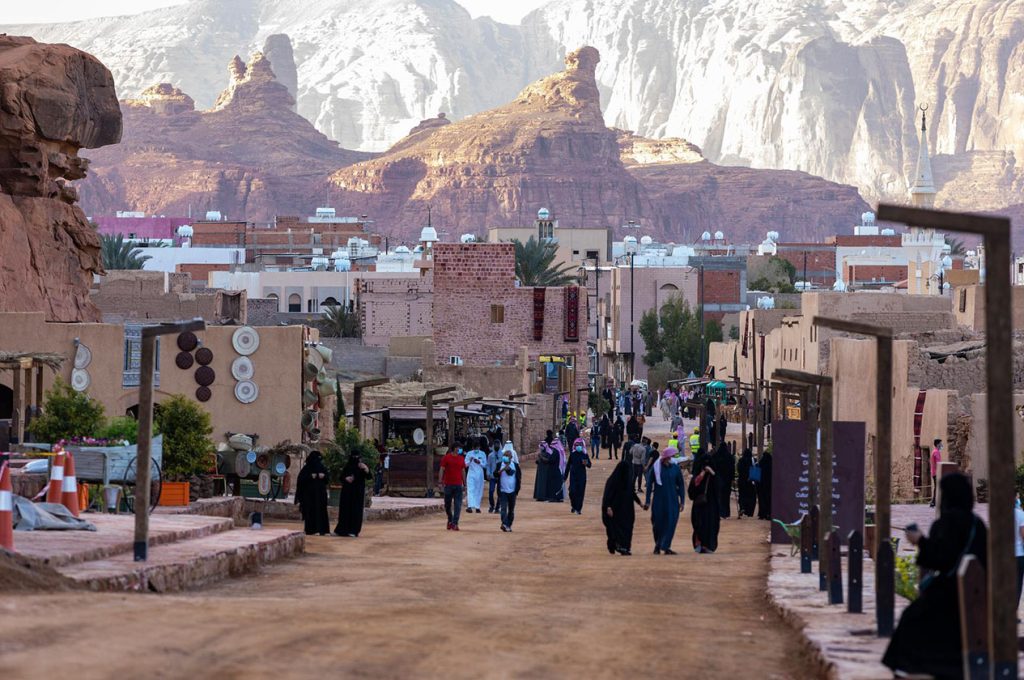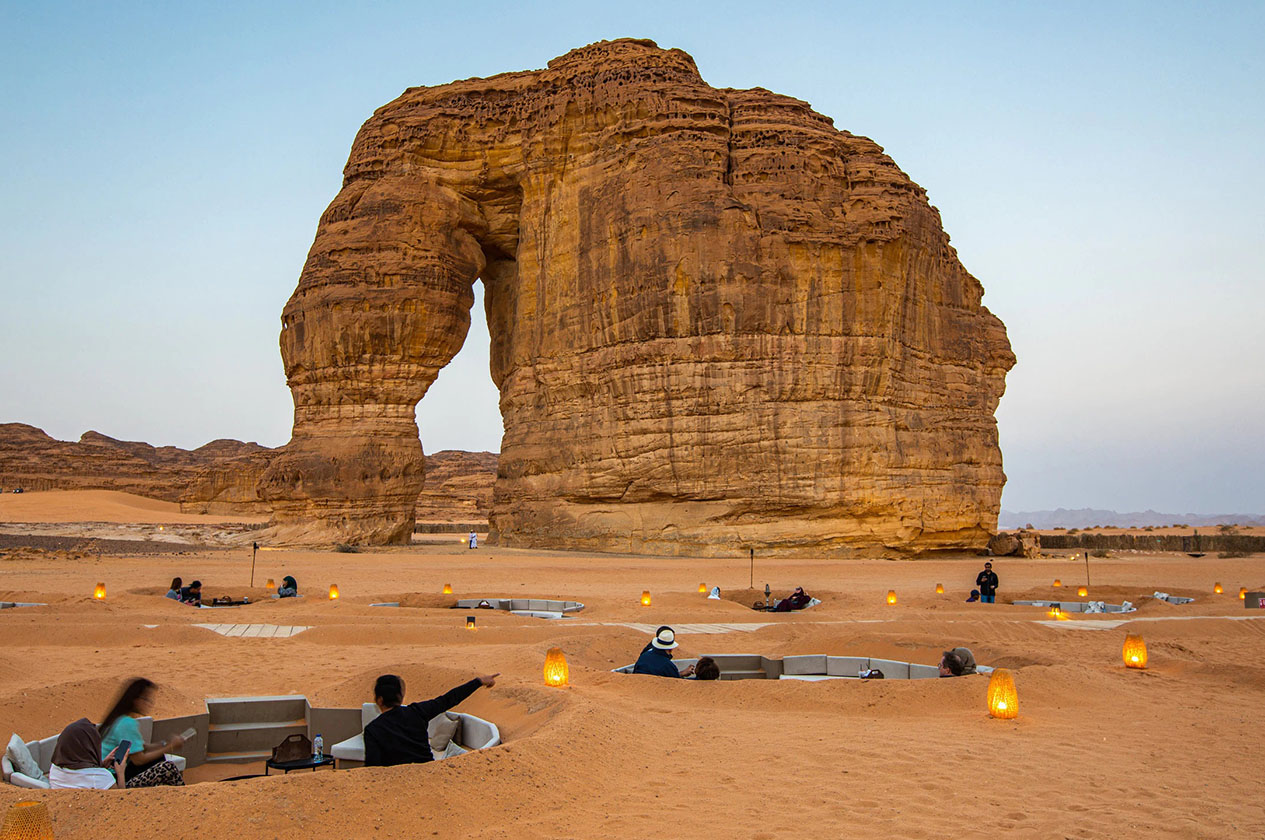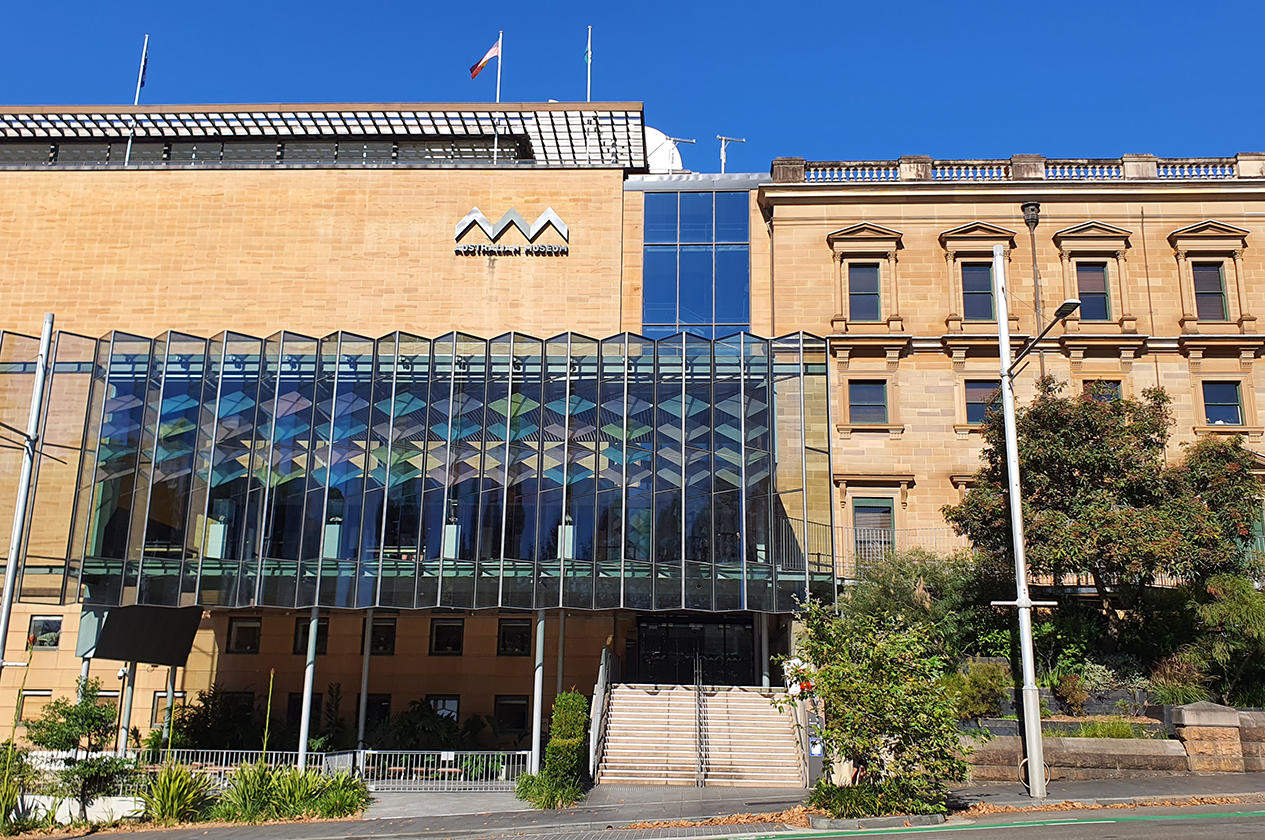Al Ula is a mesmerizing historical treasure located in the northwest of Saudi Arabia. Stepping into this archaeological wonderland feels like journeying back in time. The ancient city boasts remarkable remnants of past civilizations, such as the renowned UNESCO World Heritage Site, Hegra, formerly known as Madain Saleh.
Personal Experience
My venture into Hegra, nestled within Al Ula’s enigmatic landscape, proved to be a mesmerizing journey through time. Hegra, renowned for its Nabatean tombs hewn into majestic sandstone cliffs, unfolded before me as a testament to ancient craftsmanship and historical grandeur.
The meticulously carved facades, adorned with intricate designs and ancient inscriptions, stood as silent witnesses to centuries of civilization. Each detail etched into the sandstone cliffs seemed to narrate stories of a bygone era, evoking a sense of wonder and reverence for the ingenuity of the Nabatean people.
Standing amidst these architectural marvels was an awe-inspiring experience. The sheer magnitude and precision of the carvings projected a profound sense of respect for the dedication and skill of the ancient craftsmen. It was a humbling moment, realizing the enduring legacy and cultural significance preserved within these sandstone structures.
The site was thoughtfully maintained, allowing visitors to immerse themselves in its historical significance comfortably. Well-informed guides provided comprehensive insights into the history and cultural context of each tomb, enriching the experience with their knowledge and passion for the site’s heritage.
However, the amenities were relatively limited, presenting a minor inconvenience. Sparse food and water stalls urged visitors to plan accordingly and carry their provisions for a more comfortable exploration. Despite this, the lack of amenities did little to detract from the awe-inspiring atmosphere and the profound impact of the ancient tombs.
Hegra in Al Ula is an unparalleled archaeological gem that deserves every bit of its acclaim. Its intricate craftsmanship, historical significance, and the sheer majesty of the carved facades make it an indispensable destination for anyone seeking a profound connection with ancient civilizations and architectural excellence.
Old Town of Al Ula
Nestled at the heart of Al Ula, the Old Town stands as a living testament to the region’s cultural richness and historical significance. Stepping into this ancient enclave felt like traversing a corridor through time, adorned with traditional stone buildings, labyrinthine alleys, and an aura steeped in Arabian heritage.
Architectural Splendor:
Meandering through the Old Town’s alleys, I was instantly captivated by the architectural marvels that lined the cobblestone streets. The weathered stone structures, adorned with intricate carvings and timeless designs, spoke volumes about the craftsmanship and artistry of generations past. Each building seemed to narrate tales of the past, preserving the essence of a bygone era.
Timeless Heritage:
The Old Town’s ambiance exuded a sense of authenticity and cultural legacy. As I wandered, I was transported into an era where history and tradition coalesced seamlessly. The remnants of ancient dwellings and historical landmarks stood as silent witnesses, sharing fragments of the region’s illustrious past.
Cultural Tapestry:
Immersing myself in the Old Town’s atmosphere, I felt a palpable connection to the Arabian heritage. The vibrant streets echoed with the whispers of history, offering glimpses into the daily lives and customs of the people who once thrived within these ancient walls.

Preserving Legacy:
The Old Town is not just a relic frozen in time; it’s a living heritage that has withstood the test of time. Its preservation efforts serve as a bridge between antiquity and the contemporary world, preserving and honoring the cultural legacy of Al Ula.
Visiting the Old Town of Al Ula was an enriching experience, allowing me to delve into the captivating history and cultural tapestry of the region. It was a reverential journey through a timeless labyrinth that continues to stand as a testament to the enduring legacy of Arabian heritage.
Exploring Hegra: Unveiling Nabatean Wonders
Nestled approximately 22 kilometers north of Al Ula lies Hegra, a UNESCO World Heritage Site revered for its breathtaking necropolis, a vestige of the ancient Nabatean civilization. This sprawling site boasts over a hundred intricately carved rock tombs and facades, each a testament to the architectural finesse and cultural depth of the Nabateans.
Ancient Marvels:
As I embarked on my journey through Hegra, the sight of the rock-hewn tombs and elaborate facades carved into the sandstone cliffs was awe-inspiring. The artistic precision and intricate detailing displayed on each structure echoed the craftsmanship of an ancient civilization.
Timeless Narratives:
Each tomb and facade seemed to hold a narrative of its own, evoking a sense of wonder and curiosity about the rituals and customs of the Nabateans. The inscriptions and motifs etched into the rock surfaces hinted at stories and traditions that have endured the test of time.
Tickets and Entry:
For visitors, securing entry involves acquiring tickets priced between 60 to 100 Saudi Riyals, with costs varying based on citizenship. It’s advisable to obtain tickets through official channels or in advance to streamline the visit and ensure a seamless exploration of this historic site.
Cultural Legacy:
Hegra stands as a poignant testament to the Nabateans’ ingenuity and cultural legacy. The preservation efforts undertaken here underscore the significance of this ancient necropolis, offering visitors a profound glimpse into the rich heritage and architectural prowess of the Nabatean civilization.
My excursion to Hegra was a captivating odyssey, a profound immersion into the mysterious world of the Nabateans. The meticulously carved rock formations and ancient tombs painted a vivid picture of a civilization steeped in history, leaving an indelible imprint on my exploration of Al Ula’s remarkable historical tapestry.
Exploring Al Ula Museum: A Journey Through Time
Nestled within the town of Al Ula, adjacent to the Old Town enclave, the Al Ula Museum stands as a beacon illuminating the region’s rich heritage and historical significance. This museum serves as a gateway to unravel the cultural tapestry woven through the annals of time.
Immersive Cultural Journey:
Stepping into the Al Ula Museum felt like embarking on a captivating voyage across epochs. The meticulously curated exhibits and artifacts unveiled a vibrant narrative of Al Ula’s historical journey, offering a glimpse into the lives, traditions, and legacies of its past inhabitants.
Treasures from the Past:
The museum’s displays were a captivating fusion of ancient relics, intricate artworks, and archaeological findings that painted a vivid picture of the region’s diverse history. Each artifact seemed to narrate its story, preserving fragments of bygone eras and igniting curiosity about the cultures that once flourished here.
Accessibility and Admission:
The Al Ula Museum, an illustrious repository of cultural richness, beckons enthusiasts and explorers into its realm of historical wonders. This bastion of knowledge and heritage offers a doorway to Al Ula’s captivating past at a nominal entry fee ranging from 10 to 20 Saudi Riyals per person.
Inclusive Admission Policies:
The museum’s commitment to fostering a spirit of inclusivity and enlightenment is exemplified by its approachable entry fees. These modest charges, coupled with discounted rates for children and students, ensure that the allure of Al Ula’s heritage is accessible to a wide spectrum of visitors.
Affordable Insight into History:
The nominal admission fees belie the sheer magnitude of cultural wealth housed within the museum’s walls. For a modest fee, patrons gain access to an extensive collection of artifacts, relics, and historical exhibits that weave together the intricate tapestry of Al Ula’s narrative through time. This affordability makes the museum an inviting destination for families, scholars, and culture enthusiasts.
Promoting Cultural Appreciation:
The Al Ula Museum’s commitment to reasonable admission rates is a testament to its dedication to fostering cultural appreciation and understanding. By making heritage exploration financially attainable, it becomes a platform where diverse audiences converge to learn, reflect, and appreciate the rich history of Al Ula.

The Al Ula Museum’s ethos of accessibility in admission rates symbolizes its pledge to democratize cultural exploration and education. This commitment ensures that the vibrant heritage of Al Ula is accessible and cherished by all those who seek to delve into its captivating past.
Custodian of Heritage:
The Al Ula Museum stands as a custodian of Al Ula’s legacy, meticulously preserving and presenting its cultural wealth. Its commitment to conservation and education provides visitors with an invaluable platform to connect with the region’s rich heritage.
My visit to the Al Ula Museum was an enlightening expedition that transcended time, allowing me to traverse through Al Ula’s diverse historical chapters. It was an immersive and enriching experience that deepened my appreciation for the region’s captivating past.
The Al Ula Museum stands not merely as a bastion of artifacts and relics but as a beacon of accessibility, inviting individuals from all walks of life to embark on a journey through Al Ula’s rich heritage. Its commitment to modest admission fees and discounted rates for children and students underscores a vision where cultural enlightenment knows no boundaries.
By ensuring that the treasures of Al Ula’s past are within reach for everyone, the museum fosters a spirit of inclusivity, enabling visitors to immerse themselves in the cultural mosaic that defines this enigmatic region. Through its accessible admission policies, the Al Ula Museum remains a testament to the belief that heritage and knowledge should be celebrated and cherished by all.
As the museum continues to welcome curious minds and history enthusiasts, its dedication to accessibility in heritage preservation resonates, promising an enduring legacy where the beauty and richness of Al Ula’s heritage are embraced and treasured by generations to come.




